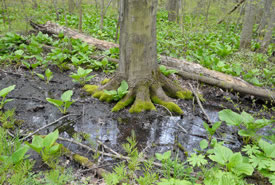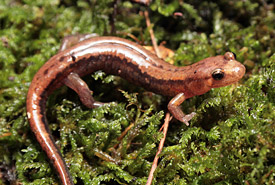Vernal pools (Part Two)

Vernal pool (Photo by Bernt Solymar)
In Part One of this blog I provided a 101 on vernal pools; why this seasonal ecosystem created from rainfall that accumulates in land depressions is so important to wildlife, in particular amphibians. Here I will go into detail about the conservation of vernal pools and the species that rely on them.
Conservation groups are doing their best to establish rescue missions, but it involves multiple projects to find every answer needed. In Quebec, the Kenauk property is super important for Canada’s biodiversity. A lot of research is focused in this area, and for good reason too; it’s huuuuge! With 260 square kilometers, there’s a lot of potential hotspots for vernal pool formation.
The Kenauk Research Institute, with the help from Le Centre d’Enseignement et de la Recherche en Foresterie de Sainte-foy (CERFO), have started to map out vernal pools with a laser remote technology called LIDAR (Light Detection and Ranging). This technology maps out the landscape using photographs. As it is super precise and sophisticated, it’s also pricey and time consuming. To keep up the research, the teams need support from grants.

Allegheny mountain dusky salamander (Photo by Frédérick Lelièvre, Quebec Government)
In the meantime, the Nature Conservancy of Canada (NCC) is collaborating with the Kenauk Institute and CERFO and university researchers to undergo invertebrate and amphibian inventories. Toads, frogs, and especially salamanders are experts at hiding, so the easiest method to use is environmental DNA sampling. This means to take samples of water from the vernal pools and the soil surrounding.
But how’s that going to help identify amphibians? Luckily, just like reptiles, most amphibians shed their skin! Particles can be found in the water and earth samples and then sequenced to identify the species. Furthermore, catching and identifying insects helps, since amphibians eat insects. Where specific insects are flying about, the amphibian predators should be lurking behind!
It’s a lot of work, but it’s worth it knowing we can help save species. And you can help too! Campers who find vernal pools can always contact the research sites to announce their findings. If you would like to get into herpetology (aka the study of amphibians and reptiles), you can check out NCC’s list of species in Canada. That way, if you ever find on one a hiking trip, you too can announce your finding to researchers! Visit the following links for more info!


